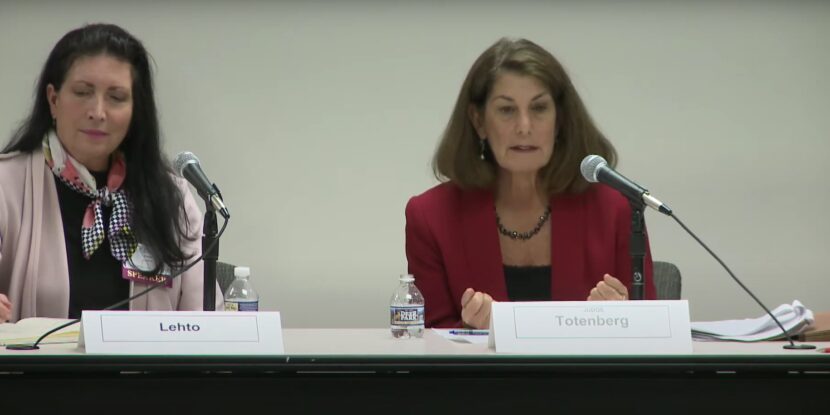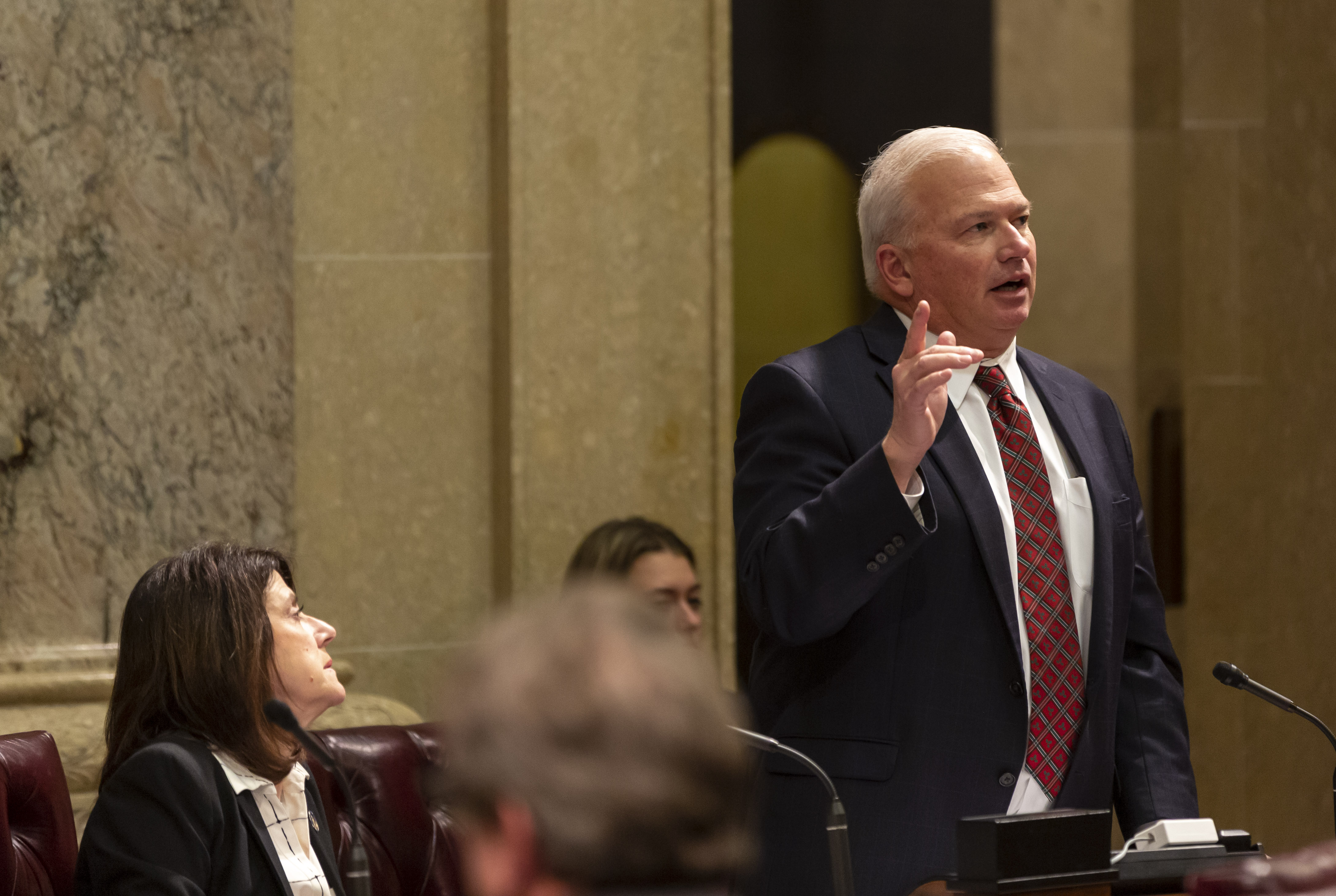
PULSE POINTS:
❓What Happened: The Senate approved a resolution to oppose President Donald J. Trump’s tariffs on Canadian imports, with the legislation aimed at repealing the emergency declaration permitting these trade levies.
👥 Who’s Involved: Senators Rand Paul (R-KY), Mitch McConnell (R-KY), Susan Collins (R-ME), and Lisa Murkowski (R-AK) joined with Senate Democrats to support the resolution, which is sponsored by Senator Tim Kaine (D-VA).
Your free, daily feed from The National Pulse.
📍 Where & When: The Senate passed the measure on Wednesday following President Trump’s “Liberation Day” event at the White House Rose Garden, where he announced that substantial import duties would be imposed on foreign nations with high tariffs on U.S. exports.
💬 Key Quote: Senator Rand Paul stated, “Taxation without representation is tyranny,” characterizing tariffs as a form of taxation and arguing the Constitution forbids one person from enacting taxes.
⚠️ Impact: The resolution likely won’t advance in the GOP-controlled House.
IN FULL:
In a Senate session on Wednesday, a resolution challenging President Donald J. Trump’s tariffs on imports from Canada was advanced to the House of Representatives, with Senators approving the bill in a 51-48 vote. Introduced by Hillary Clinton’s former running mate, Senator Tim Kaine, the measure seeks to revoke the emergency declaration that sanctioned these tariffs by citing the influx of fentanyl across the border. This vote saw four Republican defections, with Sens. Rand Paul, Mitch McConnell, Susan Collins, and Lisa Murkowski joining the Democrat minority to pass the measure.
The resolution’s passage is arguably a symbolic win for Senate Democrats who have worked to derail President Trump’s America First trade agenda. However, while Democrats in the Senate were able to peel off just enough Republican votes to pass the anti-tariff resolution, it is unlikely to advance in the House, where Republican leaders will likely move to kill it before it can move to the floor for a vote.
“[W]e are here before the Senate because one person in our country wishes to raise taxes,” Sen. Paul argued in support of the Democratic resolution on the Senate floor late last night. “Well, this is contrary to everything our country was founded upon. One person is not allowed to raise taxes. The Constitution forbids it.”
“This is a tax, plain and simple,” he reiterated, adding: “Taxation without representation is tyranny.”
While tariffs can technically be categorized as a form of taxation, the import duties are not borne by American consumers for the most part. Instead, foreign companies impacted by tariffs will often absorb a significant portion of the import duty to preserve their market position—essentially opting to take a short-term revenue loss to ensure they maintain their consumer base for the long term.
It is also highly questionable to suggest that there is a lack of “representation” when an elected President with a mandate from the American people raises tariffs.
The Senate’s passage of the anti-tariff resolution came just hours after President Trump announced a 10 percent blanket tariff on all foreign imports and imposed additional, more targeted trade levies on a number of countries that have high tariffs on U.S. goods.

PULSE POINTS:
❓ What Happened: Several members of President Donald J. Trump’s National Security Council (NSC) were fired on Thursday following a visit from independent investigative reporter Laura Loomer highlighting neocon infiltrators on the team.
👥 Who’s Involved: Laura Loomer pressed the administration to act, while a U.S. official and a source familiar confirmed the firings, with up to 10 NSC staffers, including senior directors, reportedly axed.
Your free, daily feed from The National Pulse.
📍 Where & When: The firings hit Washington, D.C., on April 3, 2025, one day after Loomer’s Oval Office visit on April 2, 2025.
💬 Key Quote: A U.S. official said Loomer was “furious that ‘neocons’ had slipped through the vetting process,” calling the firings a “bloodbath.”
⚠️ Impact: The shakeup signals Trump’s intent to root out establishment hawks.
IN FULL:
President Donald J. Trump’s National Security Council was rocked by a string of firings on Thursday, just 24 hours after conservative firebrand Laura Loomer visited the Oval Office. Sources say Loomer handed Trump “research and evidence” targeting “neocons” on the Council—holdovers from the Bush-era foreign policy establishment. By the next day, multiple NSC members, possibly as many as 10, including senior directors, were out the door.
A U.S. official said that Loomer was livid about “neocons slipping through” the administration’s vetting process, and while it’s not yet confirmed her visit directly sparked the purge, the timing indicates a possible connection. The source called it an “anti-neocon move,” while the official warned of an ongoing “bloodbath.” still unfolding.
The firings also follow “Signalgate,” which saw National Security Advisor Mike Waltz accidentally loop an anti-Trump journalist into a group chat about strikes against the Houthis in Yemen. However, no connection between the firings and this misstep has been established.
show less

PULSE POINTS:
❓What Happened: The globalist magazine The Economist has defended Marine Le Pen’s right to run for office, recently stripped away by a court ruling.
👥 Who’s Involved: The Economist, Marine Le Pen, French courts.
Your free, daily feed from The National Pulse.
📍 Where & When: The article appeared in The Economist on April 1.
💬 Key Quote: “The aim should be to punish the offender without also punishing French democracy,” the magazine argues.
⚠️ Impact: One of the major media outlets for globalists, the stance could reflect a shift against the lawfare deployed against populists in recent years.
IN FULL:
The globalist magazine The Economist has come out to defend populist French politician Marine Le Pen, who has been barred from running for office in France for five years and placed under house arrest for two years. The sentences came after Le Pen and several other members of her party, the National Rally, were found guilty of supposedly misusing European Union (EU) funds while serving as Members of the European Parliament (MEPs).
The magazine questions whether Le Pen should be barred from running for office in the upcoming 2027 presidential election, noting that she is the current leader in the polls.
“The danger of courts aggressively sentencing politicians is that both the law and the courts become seen as partisan. Judiciaries rely on citizens accepting verdicts with which they disagree,” the magazine warns. Barely half, just 56 percent, of the French public believe Le Pen was treated in an unbiased manner.
While the magazine argues that Le Pen should serve two years of house arrest, it states that she should be allowed to run for president in 2027. “The aim should be to punish the offender without also punishing French democracy,” the magazine states.
The court ruling to ban Le Pen from running for office comes after she and other National Rally members were found guilty of embezzling European Union funds by using EU-funded parliamentary assistants to perform domestic party work. Le Pen argued that the charges were bogus lawfare, as parliamentary assistants are “political assistants to elected officials, political by definition.”
Many observers, including liberal journalists, have noted that parliamentary assistants performing political work is commonplace in the European Parliament, meaning Le Pen was almost certainly singled out for her political views.
show less

PULSE POINTS:
❓What Happened: The number of Americans filing initial claims for unemployment benefits decreased by 6,000 to 219,000 last week, according to the Labor Department.
👥 Who’s Involved: The Labor Department released the data in its regular unemployment claims report.
Your free, daily feed from The National Pulse.
📍 Where & When: The report covered the week ending March 29, with data provided on March 22 as well.
💬 Key Quote: The department stated the decline was less than predicted applications, which analysts forecasted at 226,000 new claims.
⚠️ Impact: The decrease suggests stability in the labor market, keeping claims within a long-standing range of 200,000 to 250,000, although the total benefiting from unemployment rose to 1.9 million.
IN FULL:
The American labor market continues to defy skeptics and remain robust and stable despite market analysts predicting sizable layoffs across industries. Data released by the United States Department of Labor on Thursday shows that the number of initial claims for unemployment benefits fell last week, defying analysis forecasts that expected claims to rise. The filing for jobless benefits dipped by 6,000 to a total of 219,000 for the last week of March, coming in below forecasts, which predicted 226,000 new claims.
The four-week moving average for claims, which provides a more stable view by minimizing the volatility of weekly reports, showed a decrease of 1,250, bringing the average to 223,000. While this suggests the labor market continues to remain strong, the number of individuals receiving unemployment benefits did increase by a small amount. For the week ending March 22, the total rose by 56,000, reaching 1.9 million.
The ongoing figures reflect a labor market that, although experiencing minor fluctuations, remains largely steady.
show less

A 50-year-old man has been arrested after apparently attempting a suicide car bombing in the Netherlands on Thursday morning. The unnamed suspect’s car burst into flames in Amsterdam’s Dam Square, where a Ukrainian from the partially Russian-controlled Donetsk region carried out a mass stabbing last Thursday.
Video footage from the scene shows the suspect emerging from his blazing vehicle, on fire, and rolling on the ground in an attempt to put out the flames. Later video footage shows him shuffling around the square, still partly on fire, until law enforcement steps in and douses him with fire extinguishers.
Your free, daily feed from The National Pulse.
Police say they “suspect that the driver caused the fire himself,” but a motive for the possible attack is unknown or undisclosed as of the time of publication. He is described as a Dutch national, although his ethnic and religious background is unclear.
The authorities report no injuries to bystanders are known, although some eyewitnesses describe glass flying “into our necks” when the car’s windows blew out.
Last week, a Ukrainian named Roman D. carried out a mass stabbing in the same square, wounding five people, including a 67-year-old American woman and a 69-year-old American man, before he was detained by bystanders, including a British tourist who pinned him down until police arrived.
The Ukrainian reportedly had bogus papers for multiple false identities, and an investigation into his possibly terroristic motives is ongoing.
BREAKING:
Video of the moment the failed car bomb exploded at the main square in Amsterdam, Netherlands.
A car is on fire after a small explosion. The police believe it’s a deliberate attack.
It’s the same location where 5 people were stabbed a few days ago. pic.twitter.com/6xmudcjXE4
— Visegrád 24 (@visegrad24) April 3, 2025
show less
A 50-year-old man has been arrested after apparently attempting a suicide car bombing in the Netherlands on Thursday morning. The unnamed suspect's car burst into flames in Amsterdam's Dam Square, where a Ukrainian from the partially Russian-controlled Donetsk region carried out a mass stabbing last Thursday. show more

PULSE POINTS:
❓What Happened: New York City Mayor Eric Adams announced his intention to seek reelection as an independent candidate.
👥 Who’s Involved: Eric Adams, currently serving as mayor; Former Governor Andrew Cuomo, who is also running for mayor.
Your free, daily feed from The National Pulse.
📍 Where & When: The announcement was made during an interview with POLITICO, published on Thursday.
💬 Key Quote: Adams stated, “I’m in the race to the end… I’m not running on the Democratic line.”
⚠️ Impact: This decision signifies a shift in political strategy following the recent dropping of bribery charges against him.
IN FULL:
New York City Mayor Eric Adams has revealed his intention to run for reelection as an independent candidate, marking a significant shift in his political strategy. This announcement came during an interview with POLITICO, published Thursday. Adams’s departure from the Democratic Party and the launch of his independent bid for reelection comes on the heels of federal prosecutors deciding to drop all bribery and related charges against the New York City Mayor.
“I have been this racehorse that has been held back. This is so unnatural for me,” Adams said on Thursday. He continued: “I’m in the race to the end. I’m not running on the Democratic line. It’s just not realistic to turn around my numbers and to run a good campaign (from) where we are right now.”
In September, Adams faced allegations of accepting illegal campaign contributions from the Turkish government, leading to federal bribery, conspiracy, and campaign finance charges. He pleaded not guilty to all counts. However, earlier this year, the Department of Justice (DOJ) moved to dismiss the corruption charges, which were officially dropped on Wednesday after a federal judge approved the government’s dismissal motion. Adams expressed feeling “handcuffed” by the legal proceedings.
A recent survey conducted by Quinnipac University showed Adams with just a 20 percent approval rating among New Yorkers, suggesting his independent bid will face serious headwinds heading into the November election. Adams has already drawn a serious challenger in the mayoral race, with former New York Governor Andrew Cuomo also entering.
Over three million New York City residents are registered Democrats, and another 1.1 million identify as independents, while just 558,778 are registered as Republicans. However, a crowded Democrat primary field could result in a far-left candidate like Democratic Socialist Zohran Mamdani narrowly edging out a win, which Adams’s allies believe would be the best-case scenario for his independent reelection bid.
show less

PULSE POINTS:
❓What Happened: Layoffs announced by employers in the U.S. increased significantly in March—but almost half are Washington, D.C. bureaucrats, according to the Department of Government Efficiency (DOGE).
👥 Who’s Involved: Federal workers and contractors, DOGE, and DOGE frontman Elon Musk.
Your free, daily feed from The National Pulse.
📍 Where & When: These developments occurred in Washington D.C. during March.
💬 Key Quote: Andrew Challenger of outplacement firm Challenger, Gray & Christmas noted, “Job cut announcements were dominated last month by Department of Government Efficiency plans to eliminate positions in the federal government.”
⚠️ Impact: With 497,052 layoffs in the first three months of the year, this represents the highest first-quarter total since 2009, with significant implications for federal agencies and leftist non-profits.
IN FULL:
U.S. employers announced layoffs in March at levels unprecedented since the pandemic-induced recession—but this was driven largely by sizable cuts among federal workers and contractors. Data released by global outplacement firm Challenger, Gray & Christmas on Thursday indicated a 60 percent surge in planned job reductions, amounting to 275,240 positions last month. This figure marks the highest since May 2020, positioning it as the third-largest monthly total recorded.
These reductions were significantly concentrated in Washington, D.C., attributed mainly to the federal government sector. Over the past two months, approximately 280,253 planned federal worker and contractor layoffs have impacted 27 agencies as the Trump administration seeks to eliminate waste and inefficiency and bring federal spending under control. The ripple effect of terminating federal aid or contracts further contributed to 4,429 job cuts, notably affecting non-profits—often engaged in leftist activism—and health-oriented organizations, possibly due to the administration’s efforts to defund abortions and transgenderism.
Andrew Challenger of Challenger, Gray & Christmas commented, “Job cut announcements were dominated last month by Department of Government Efficiency plans to eliminate positions in the federal government.”
Judicial orders have facilitated the reinstatement of around 24,000 workers. Reports indicate a significant reshuffle within federal ranks is ongoing, documenting 3,972 rehired policymakers as part of March’s hiring plans.
An anticipated governmental employment report suggests an addition of 135,000 nonfarm payroll jobs for March, maintaining an unemployment rate of 4.1 percent.
show less

PULSE POINTS:
❓What Happened: U.S. District Judge Amy Totenberg ruled to dismiss a case challenging Georgia’s electronic voting system, citing a lack of standing, despite recognizing substantial concerns about the system’s security and administration.
👥 Who’s Involved: The ruling affects plaintiffs including the Coalition for Good Governance and various Georgia voters. The case, Curling v. Raffensperger, has been ongoing since 2017.
Your free, daily feed from The National Pulse.
📍 Where & When: The decision was issued in the Northern District of Georgia on a late Monday.
💬 Key Quote: “Plaintiffs lack standing to pursue their claims because neither of these asserted injuries constitute an invasion of a legally protected interest under governing precedent,” Judge Totenberg wrote.
⚠️ Impact: The dismissal leaves Georgia’s use of the Ballot Marking Device system in place despite security concerns, while plaintiffs consider exploring an appeal.
IN FULL:
In Georgia, U.S. District Judge Amy Totenberg has dismissed a long-standing case aiming to move the state’s election system to hand-marked paper ballots. The case, Curling v. Raffensperger, initiated in 2017, sought to replace the electronic voting system currently in use, citing risks regarding the security and accuracy of the Ballot Marking Device (BMD) system. The Barack Obama-appointed judge’s decision, issued late on April 1, found the plaintiffs lacked legal standing—despite acknowledging significant concerns about the electronic voting system’s administration and security.
“Plaintiffs lack standing to pursue their claims because neither of these asserted injuries constitute an invasion of a legally protected interest under governing precedent,” Judge Totenberg said.
The plaintiffs in this case included the Coalition for Good Governance and several Georgia voters. They have argued that the existing system, which relies on a QR code to tally votes, does not allow voters to verify that the system recorded their intentions accurately.
The QR code used on ballots is not readable to voters, prompting concerns over the integrity of the vote tabulation. Judge Totenberg, referencing the plaintiffs’ injuries as not legally actionable, stated that these concerns do not invade a legally protected interest.
A major point of contention for the plaintiffs was the system’s vulnerability to potential manipulation. Dr. J. Alex Halderman, a computer science expert, provided testimony during the trial demonstrating how the system could be exploited, including altering QR codes to change voter selections and accessing the system via simple physical manipulation.
Despite these concerns, the ruling affirms the use of Georgia’s electronic voting system for the time being, leaving the future of the voting system’s security unresolved.
The ruling comes just days after the Trump administration and Attorney General Pam Bondi dropped a lawsuit against electoral reform in Georgia, initiated by the former Biden government. That lawsuit had demanded that Georgia scrap its voting laws passed after the 2020 elections. This included measures such as stricter voter ID requirements for mail-in ballots and more.
show less

PULSE POINTS:
❓What Happened: A court filing revealed that a Trump administration official from the Department of Government Efficiency (DOGE) is overseeing the U.S. Institute of Peace (USIP).
👥 Who’s Involved: Nate Cavanaugh, an official of the Department of Government Efficiency, alongside board members from the U.S. Institute of Peace.
Your free, daily feed from The National Pulse.
📍 Where & When: The developments were filed in federal court, with a status hearing conducted on Tuesday.
💬 Key Quote: “The deal is no longer merely ‘proposed’ but done, rendering plaintiffs’ requested relief moot as to that property,” said Judge Beryl Howell.
⚠️ Impact: The property of the U.S. Institute of Peace is in the process of being transferred to the General Services Administration, a move which could conclude despite judicial intervention efforts.
IN FULL:
Department of Government Efficiency (DOGE) official Nate Cavanaugh has been appointed to replace the U.S. Institute of Peace’s temporary president, according to a recent court filing. The appointment, authorized by two of the institute’s board members, was revealed during a status hearing before U.S. District Court Judge Beryl Howell on Tuesday.
Established by Congress in 1984, the U.S. Institute of Peace has operated as a quasi-non-governmental organization (NGO) for decades—despite it ostensibly falling under the authority of the federal government’s executive branch. In February, President Donald J. Trump issued an executive order mandating the institute downsize its activities to a “statutory minimum.” However, the organization’s far-left leadership dismissed the order, arguing that the institute is a congressionally chartered NGO and not technically part of the executive branch.
The rejection of Trump’s executive order resulted in the institute’s leadership and staff being removed by police last month, with the Trump White House appointing an acting president to oversee its operations. In response to President Trump’s actions, the former leadership of the U.S. Institute of Peace filed a lawsuit in federal court claiming the Trump administration had engaged in an illegal attempt to seize control of the institute. The filing asked Judge Howell to halt the reorganization in order to stop what they allege is a “takeover by force.”
Despite the litigation, Cavanaugh has begun transferring the institute’s property to the General Services Administration (GSA), the government agency that oversees federal contracts and assets. Notably, the GSA has already terminated several federal leases at the urging of DOGE.
Tuesday’s status hearing regarding the request to halt the institute’s reorganization lasted for several hours. Judge Howell eventually ruled that the former leadership’s claims to the institute’s property were moot. “The deal is no longer merely ‘proposed’ but done, rendering plaintiffs’ requested relief moot as to that property,” the judge determined.
show less

PULSE POINTS:
❓What Happened: Momodou Taal, a student from Cornell University, left the United States after his student visa was revoked due to involvement in anti-Israel demonstrations.
👥 Who’s Involved: Momodou Taal, a dual citizen of the United Kingdom and Gambia; U.S. Immigration and Customs Enforcement (ICE); the Trump administration.
Your free, daily feed from The National Pulse.
📍 Where & When: Cornell University in Ithaca, New York; Taal’s departure occurred after a recent federal court decision.
💬 Key Quote: “I have lost faith I could walk the streets without being abducted,” Taal said online.
⚠️ Impact: Taal’s departure sheds light on the increased deportation measures for foreign students involved in political agitating. Other international students facing similar issues include Columbia University’s Mahmoud Khalil and Georgetown University’s Badar Khan Suri.
IN FULL:
According to his own online statements, a Cornell University student whose visa was rescinded due to participation in anti-Israel activism has fled the United States. Momodou Taal, a 31-year-old citizen of the Gambia and the United Kingdom, disclosed that he left voluntarily. He cited fears of detention by immigration authorities. He also stated that his decision followed a recent federal ruling that refused to intervene against potential detention while he contested his deportation order.
“I have lost faith I could walk the streets without being abducted,” Taal claimed. U.S. authorities attributed Taal’s recent visa cancelation to his involvement in anti-Semitic campus demonstrations. They were also said to be a violation of university policies, which fostered a hostile setting for Jewish students.
Taal recently attempted to challenge his deportation, asserting his actions should be protected by free speech. However, he reported that the first motion in his lawsuit was denied. He expressed skepticism about remaining in the country without apprehension by Immigration and Customs Enforcement (ICE) agents.
Taal’s case is just one of several cases involving students who were ordered to leave amid allegations of involvement in anti-Semitic protests. Notably, Columbia University’s Mahmoud Khalil and Georgetown University’s Badar Khan Suri are entangled in similar disputes. President Donald J. Trump has pledged a strict stance on anti-Israel activism by foreigners at educational institutions, resulting in increased scrutiny and deportations.
show less

PULSE POINTS:
❓What Happened: Christine Grady, a bioethicist at the National Institutes of Health (NIH) and the wife of Anthony Fauci, was notified of a layoff amidst a restructuring at the Department of Health and Human Services (HHS).
👥 Who’s Involved: Christine Grady, Anthony Fauci, HHS Secretary Robert F. Kennedy Jr., NIH officials including Clifford Lane and Emily Erbelding.
Your free, daily feed from The National Pulse.
📍 Where & When: The layoffs were announced on Tuesday; related locations include NIH and Indian Health Service field offices in Alaska, Montana, and Minnesota.
💬 Key Quote: An NIH official described Grady as “a good person with a major conflict of interest,” referring to ethical challenges faced during the suppression of the Wuhan lab leak hypothesis.
⚠️ Impact: The restructuring could mean significant changes in administration at NIH.
IN FULL:
Christine Grady, a prominent bioethicist and the wife of controversial former National Institutes of Health (NIH) official Anthony Fauci, is among several health officials who received layoff notifications on Tuesday, according to reports. This move comes as part of a post-pandemic restructuring effort by the Department of Health and Human Services (HHS), led by Secretary Robert F. Kennedy Jr.
These layoffs aim to consolidate administrative roles and modify what has been perceived as an ineffective status quo in the U.S. health administration. Alongside Grady, Clifford Lane, deputy director of clinical research and special projects at the National Institute of Allergy and Infectious Diseases, and Emily Erbelding, director of the Division of Microbiology and Infectious Diseases, have also been dismissed.
Like her husband, Grady is controversial. In 2002, she co-authored a paper with him arguing for lower care standards for medical trial participants in the Third World. During the COVID-19 pandemic, in which her husband played a prominent role, she published a paper defending the ethics of corporations “pressuring employees to get vaccinated” and “embarrass[ing] vaccine resistors,” and pushed for children to be enrolled in vaccine trials.
An NIH official cited a potential conflict of interest involving Grady, stating her marriage to Fauci impacted the ability of NIH to address ethical issues openly, especially on critical episodes like the Wuhan lab leak—which he denied or minimized for years.
Anonymous comments by an NIH source revealed that Grady was caught in a “conflicted role” due to her personal ties. “One of the problems when the coverup was going on of the Wuhan lab leak, that whole fiasco, was that they were not listening to anyone giving ethics advice,” the source explained. “If they had had someone at the table with knowledge of this, they would have said: ‘Hey do you want to play it this way, or be more transparent?’… That’s something Christine Grady could have, or should have, done. She wasn’t able to do it because she was Fauci’s wife.”
show less

 2 months ago
5
2 months ago
5


















 English (US) ·
English (US) ·